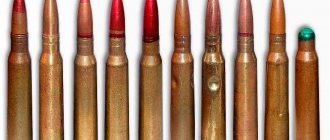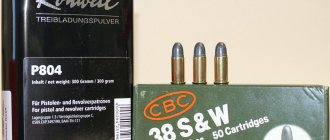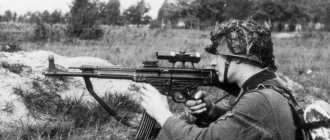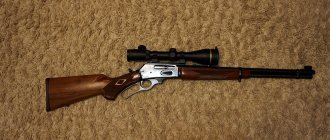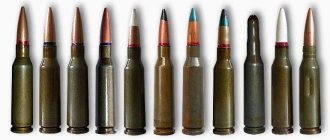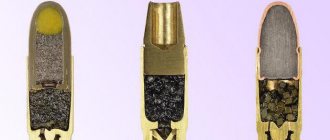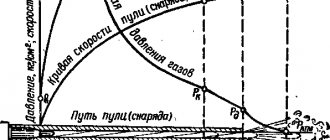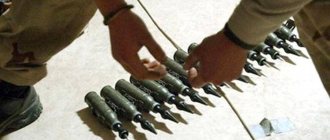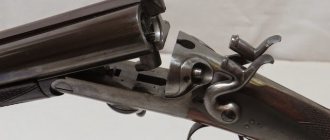| .17 Remington | |||
| Type | Hunting (varmint) | ||
| Place of origin | USA | ||
| Production history | |||
| Designer | Remington | ||
| Developed | 1971 | ||
| Manufacturer | Remington | ||
| Produced | 1971 | ||
| Characteristics | |||
| Parent case | .222 Remington Magnum | ||
| Type of shell | Rimless, bottleneck | ||
| Bullet diameter | .172 inches (4.4 mm) | ||
| Neck diameter | 0.199 in (5.1 mm) | ||
| Shoulder diameter | 0.356 in (9.0 mm) | ||
| Base diameter | 0.376 in (9.6 mm) | ||
| Rim diameter | 0.378 in (9.6 mm) | ||
| Rim thickness | 0.045 in (1.1 mm) | ||
| Case length | 1.796 inches (45.6 mm) | ||
| Full Length | 2.150 inches (54.6 mm) | ||
| Narezov twist | 1–9 | ||
| Primer type | Small rifle | ||
| Maximum CUP | 52000 CUP | ||
| Ballistic characteristics | |||
| 874 ft⋅lbf (1.185 J) | |||
| 25 g (2 g) l. | 4.123 ft/s (1.257 m/s) | 944 ft⋅lbf (1,280 J) | |
| 30 g (2 g) l. | 3,839 ft/s (1,170 m/s) | 982 ft⋅lbf (1331 J) | |
| 20 gr (1 g) Hornady V-Max | 4,200 ft/s (1,300 m/s) | 784 ft⋅lbf (1063 J) | |
The +0.17 Remington
was introduced in 1971 by the Remington Arms Company for their Model 700 rifles.
Review[edit]
It is based on the .223 Remington case, necked to 0.172 in (4.37 mm), with the shoulder set back. [4] [5] It was designed solely as a varmint cartridge, although it is suitable for smaller predators as well. There are people like P.O. Ackley, who have used it in much larger games, but this use is not typical.
Extremely high muzzle velocity (over 4,000 ft/s and 1,200 m/s), flat trajectory, and very low recoil are the main attributes of the .17 Remington. It has a maximum effective range of about 440 yards (400 m) on animals the size of prairie dogs, but the small bullet's low ballistic coefficients and sectional density mean that it is very susceptible to crosswinds at such ranges.
The smaller .172 bullet typically has a much lower ballistic coefficient than other typical varmint calibers, such as the .223 Remington bullet. Because of this, the .172 bullet loses velocity a little faster and is more sensitive to wind; but this in no way makes the cartridge useless. The advantages of this cartridge are low recoil, flat trajectory and minimal entry wound. The tiny entry wound and the usual lack of exit wound in animals the size of a coyote make it an ideal projectile for fur-bearing animals from which a hunter intends to skin. A significant disadvantage is the high rate at which such a small-bore rifle barrel can accumulate gold-plated metal contaminants, which is very detrimental to accuracy and can also eventually lead to increased pressure caused by the narrowing of the bore by the fouling. [6][7] Many .17 Remington shooters report optimal accuracy when the bore is cleaned after every 10 to 20 rounds,[6][7][8] although more modern metallurgy used for both barrels and bullets, has mitigated the pollution problem to a large extent.
The .17 Remington is also one of the few cartridges in which the weight of the powder charge often exceeds the weight of the bullet. Although this condition is known to reduce accuracy, the .17 Remington is exceptionally accurate. [7] This reputation for accuracy is due in no small part to the fact that only high-quality bolt-action and single-shot rifles were chambered from the factory.
.17 Remington cartridge
The currently used small-caliber cartridge 17 Remington was created in 1971 by the oldest US arms company founded at the beginning of the 19th century (the company declared bankruptcy in 2022) for shooting small rodents from the Remington 700 rifle. During the World Crisis of the 30s of the last century, farmers were confident that by shooting rats, gophers and prairie dogs, they would actually preserve their crops. And since the game was always on the alert, a maximum firing range of 300 - 400 meters was required. Subsequently, this shooting simply turned into a sporting hobby. This cartridge, with a very low impulse and high speed of a bullet flying strictly along a flat track, is also used for shooting training purposes. The optimal distance for firing this cartridge is 210 m, since the drift when aiming from 50 meters is up to 1 cm, from 150 meters - 3.5 cm, from 300 meters - up to 18 cm (depending on wind strength).
Interesting! .17 Remington is one of a small cohort of ammunition whose “charge” mass is greater than that of the bullet (1.3 grams per period), which creates an initial velocity of at least 1200 m/s.
When creating the .17 cartridge, the company used as a starting point a beltless bottle-shaped case with a diameter of .223, which was “shrinked” to the required size, with a corresponding slight change in its configuration. The primer remains the same "Small Rifle" and the Hollow Point bullet size is 4.37mm. The total length of the cartridge is 54.61 mm, including the cartridge case 45.62. The diameter of the components of the .1.7 Remington cartridge varies from top to bottom from 1 (bullet tip) to 9.52 mm (rim), including:
- “Dulce” - from 4.97 to 4.98 mm;
- Case slope from 4.98 to 8.93 mm;
- Case body from 8.93 to 9.51 mm;
- The bottom of the sleeve is 8.34 mm.
Disadvantages of the .17 cartridge:
- When shooting at extreme distances, the wind drift of the bullet is quite large due to its low weight.
- Weak lethality when shooting at large targets.
- Shooting birds is only of sporting interest, since due to the high-explosive effect of this high-speed bullet, the bird carcass “explodes”.
- Accelerates wear on the rifle barrel.
Very popular as a super-velocity round, the Remington 17-gauge (4.5 mm) hunting cartridge makes aiming easier due to the trajectory of the bullet and because it produces virtually no recoil when used. It is used for purely civilian purposes, for hunting small game and for sporting purposes.
Footnotes [edit]
- "Hodgdon Online Reboot Data". Archived from the original on 2007-11-11. Retrieved July 11, 2007.
- Norma product catalog
- CIP 17 Rem. (online PDF 99 KB)
- "Cartridge Dimensions". Archived from the original on 2012-04-21. Retrieved July 11, 2007.
- https://gundata.org/cartridge/1/.17-remington/
- ^ B Bussard, Michael (2010). Encyclopedia of Ammunition 2nd ed
. Minneapolis, MN, USA: Blue Book Publications. item 840. ISBN 1-936120-01-1. - ^ abc Johnson, Steve, ed. (2007). Hornady Guide to Reloading 7U Ammo
. Grand Island Nebraska: Hornady Manufacturing Company. item 978. - Hodgdon Manual Data No.
26 . Shawnee Mission, KS: Hodgdon Publishers. 1993. p. 792.
Encyclopedia of weapons
.17 Remington cartridge
Tactical and technical characteristics of .17 Remington: Caliber, mm - 4.37 (.17 Remington) Cartridge length, mm - 56.58 Case length, mm - 45.45 Case neck diameter, mm - 4.97 Case neck diameter, mm — 4.98 Case shoulder diameter, mm — 8.93 Case base diameter, mm — 9.51 Case flange diameter, mm — 9.52 Bullet weight, g — 1.3 — 3 Initial bullet speed, m/s — 1170 -1352 Bullet energy, J - 1185-1301
| Basic ballistic characteristics of .17 Remington bullets | |||
| Bullet weight, type, g | Bullet speed, m/s | Muzzle energy of a bullet, J | |
| 1 g (20 gr) BT | 1352 | 1185 | |
| 2 g (25 gr) HP | 1257 | 1280 | |
| 2 g (30 gr) HP | 1170 | 1301 | |
The .17 Remington cartridge was developed in 1971. It was based on the case of the widely used .223 Remington cartridge, the barrel of which was re-compressed to a caliber of 0.172 inches (4.37 mm). At the same time, the shape of the sleeve changed slightly. Technically, the .17 Remington is close to the .17 Ackley Bee.
The .17 Remington quickly became the most popular high-velocity ammunition in the 17-gauge (4.5 mm) cartridge. Factory production of the .17 Remington cartridge with a Hollow Point bullet was established by Remington.
The .17 Remington cartridge has a beltless bottle-shaped case, a Small Rifle type capsule, a maximum bullet diameter of 4.37 mm (.172″), case and cartridge lengths of 45.62 mm and 54.61 mm, respectively, and a barrel rifling pitch of 9 inches.
A factory cartridge from Remington with a semi-jacketed bullet weighing 1.6 g and a charge of IMR3031 powder of 1.4 g, has an initial speed and energy of 1231 m/s and 1228 J, respectively, and a powder gas pressure of 3650 bar.
When shooting at the optimal zeroing distance for this cartridge - 210 m, the bullet deviates from the aiming line no more: at a distance of 50 m - +0.8 cm, 100 m - +3.5 cm, 150 m - +3.5 cm, 200 m - +0.8 cm, 300 m - -18.0 cm.
The .17 Rem bullet, despite its low mass, has a flat trajectory and retains energy much better than the . 14-222. So, at a distance of 200 m, the bullet speed is 770 m/s, which corresponds to an energy of about 480 J (for a Makarov pistol, the bullet energy at the muzzle is 315 J).
The main disadvantages are the rapid erosion of the barrel, sensitivity to changes in weight and type of bullet.
The almost complete absence of recoil made the .17 Remington cartridge very convenient for hunting rodents and small predators. But for purposes other than varminting, this ammunition is unsuitable.
The .17 Remington cartridge is designated: .17 REMINGTON / .17 Rem / .17 AMA / .17 T216 / .17″ US XPL SBR XM216 FROM .223″ CASE / SAA 0140 / XCR 06 045 BGC 060.
‹ Cartridge .17 HMR Up Cartridge .22 LR ›
Caliber History: .35 Remington. Bullets for Bonnie and Clyde
The main target of the "thirty-fifth" was supposed to be the deer beloved by American hunters, but given the gangsters' habit of using body armor, it is not surprising that it became the choice of servants of the law
At approximately 9 a.m. on May 23, 1934, six officers of the law saw a Ford V8 approaching the ambush site. A few minutes later, the story of one of the most famous US gangs of those times ended. Bonnie Parker and Clyde Barrow were dead. In the official report, 43 gunshot wounds were counted on the bodies of the criminals, with 130-150 bullets fired in their direction. Of course, in such conditions it is quite difficult to answer the question: who exactly killed Bonnie and Clyde.
According to one version, Prentiss Morel Oakley, a Bienville County sheriff's deputy who opened fire first, holding Clyde at gunpoint, and managed to fire two shots before the rest of the participants in the hunt for the bandit couple began shooting, can claim this. Of course, it is unlikely that Prentiss would have had time to jerk the bolt or the lever of the Henry Brace so quickly. All he had to do was pull the trigger, and the rest of the work was done by the powder gases and John Browning's automatics.
To ambush Bonnie and Clyde, the sheriff's deputy armed himself with a Remington Model 8 semiautomatic rifle in .35 Rem caliber. It is interesting that this was not Prentiss’s personal weapon, and not even taken by him in the “regular” order. Several years ago he borrowed a self-loading Remington gun from a friend, a local doctor, to “hunt.” When it came to a possible shootout with Clyde’s gang, Prentiss again turned to the doctor with a request to borrow a rifle.
Another possible candidate is Texas Ranger Frank Hamer. An experienced hunter and excellent marksman, Frank became a Texas Ranger back in 1906 and has since participated in more than 50 shootouts. In 1920, his attention was attracted by... the Remington Model 8 self-loading rifle. He started with the .25Rem caliber, but after a while she gave him a specially made “Model 8” in .30Rem for selfless advertising. However, during the ambush, he used a version of the Remington chambered for .35rem, with a 15-round magazine, which at that time was produced only for police officers and other “law enforcement agencies” of the United States.
Bob Alcorn or "Manny" Gault, who was lying in ambush, may have had another Remington Model 8.
The choice of servants of the law was, of course, far from random. In November 1933, they had already inspected one Ford V8 abandoned by Clyde - Barrow, like many Americans, loved this powerful and fast car. Deciding to test fire at it with a Thompson submachine gun, Deputy Sheriff Ted Hinton was surprised to discover that out of 30 bullets, 17 hit the body, and... zero were able to penetrate it. Considering the well-known habit of some gangsters to use body armor and the fact that Bonnie and Clyde had previously made their way out of police ambushes several times, stopping them clearly required something more serious than ordinary police revolvers or shotguns.
And about two decades earlier, Remington managers were surprised to discover that, to put it mildly, they had slept through the birth of a new market segment - self-loading hunting rifles. Back in 1903, competitors from Winchester debuted their Model 1903 - albeit chambered in a small-caliber cartridge of their own design. Two years later, Winchester reinforced its championship with the new “Model 1905” in slightly more serious calibers .32SL and. 35 WSL. In order to jump on the departing train, the Remingtonians needed a small miracle. Fortunately for them, at that time there lived a man capable of performing weapon miracles - John Moses Browning. Building on his earlier patents on self-loading systems, by 1906 Remington was able to market its answer to its competitors - the Remington Autoloading Rifle. It was this rifle, after “rebranding” in 1911, that became the “Model 8”. The advantage of the “Great Eight,” as it was later called, was the fact that the design was originally designed for relatively powerful cartridges. And here at Remington they didn’t disappoint, offering a choice of four new ammunition at once. From the relatively weak, but comfortable when shooting .25 Remington, to our “hero” – the fairly large-caliber and powerful .35 Remington, also known as 9x48mm Browning. The cartridge, created on the basis of the standard army .30-06 cartridge case, was designed with a clear eye on the Winchester .30-30, popular at that time. With comparable dimensions, the new .35 had a heavier bullet and a larger caliber.
The main target for the "thirty-five" was supposed to be the deer beloved by American hunters, but Remington's very aggressive advertising promoted the new cartridge as suitable for both wolves and grizzly bears. Other advertising posters touted the .35's ability to penetrate 7.8 mm (5/16 inch in the original) steel plate.
According to modern concepts, a significant drawback of the "thirty-five" was the shape of the bullet - blunt-nosed, with a low ballistic coefficient, it significantly limited the effective range of the cartridge. On the other hand, at that time “sharp-nosed” bullets were just beginning their journey. In addition, when hunting, most people very rarely shoot further than a hundred meters - especially on forest hunts with their limited visibility. At close range, the .35Rem still works great today. At the same time, the cartridge, originally created for a self-loading rifle, owed its longevity largely to rifles with a tubular (under-barrel) magazine - for them its rounded bullets were an advantage, since they prevented the primer from being punctured by the nose of the bullet of the previous cartridge. The most popular model of this type for .35rem, the Marlin 336 rifle, has been produced since 1948 and no one plans to stop production yet. This means that the cartridge, which celebrated its centenary, will continue to be in demand. A career that may well be the envy of many much more modern ammunition.
Interestingly, in 1945, a batch of these cartridges was manufactured... in Spain, by order of General Gonzalo Queipo de Llano, thanks to which “9 mm Don Gonzalo” was added to the list of cartridge names. At the same time, the Spaniards also made a mistake in marking the cartridge packs, mixing the inch and metric systems in the manner of bad Soviet translators of American detective stories. If domestic readers were “delighted” with shooting from 45 mm Colts, then buyers of Spanish cartridges were scratching their heads about what kind of miracle guns the “Caliber 35 mm” ammunition was intended for.
Finally, we note that the auction price of the Oakley rifle in 2006 was 69 thousand dollars. Lend your rifles to representatives of the law - and perhaps your descendants will be very lucky too.
Remington cartridges
- home
- Hunting and sport shooting
- Ammo
- Remington
All brands A+A Armscor Baschieri&Pellagri Blaser Brenneke CCI Chase Clever DDupleks Dynamit Nobel Eley Federal Fiocchi Geco Hirtenberger Hornady Lapua Magtech Norma PMP Pozis PPU Record Remington Rio RWS Sako Sauvestre Sellier&Bellot Weatherby Winchester Azot APZ BPZ BSZ Glavpatron GLIF Kalashnikov KZORS Concern Kalashnikov K SPZ KHZ Magnum- To the OSA SCM TEMP Tekhkrim TPZ Refinery Faster Vetter Fortuna
Sort by:
Cartridge 22LR Remington Golden Bullet HP (525pcs)
Article: 2356789
Cartridge 22 LR Remington Eley Match EPS LFN (50pcs)
Article: 2065765
Cartridge 22 LR Remington Eley Target rifle LRN…
Article: 1915717
Cartridge 22LR Remington Golden Bullet (100pcs)
Article: 1784317
Cartridge 22 LR Remington Target 2.6g (50pcs)
Article: 1705765
Cartridge 22LR Remington Yellow Jacket HV TCHP (50pcs)
Article: 1687981
Cartridge 8x68 SN 13 Swift A-frame 18037
Article: 1645249
Cartridge 22 LR Remington Viper 2.6gr HV TCSB (50pcs)
Article: 1615009
Cartridge 22 LR Remington Thunderbolt 2.6g (50pcs)
Article: 1544845
Cartridge 300WM Remington 13.0 Swift A-Frame PSP
Article: 1195213
Cartridge 30-06Sprg Remington 9.7 Swift Scirocco…
Article: 1103233
Cartridge 30-06Sprg Remington 9.7 Accu Tip BT
Article: 1099309
300 Rem SA Ultra Mag PSP Core-Lokt Ultra Cartridge
Article: 1002541
Cartridge 30-06Sprg Remington 11.7 Swift A-Frame PSP
Article: 995701
Cartridge 308Win Remington 10.7 Swift Scirocco Bonded
Article: 926725
Cartridge 30-06Sprg Remington 11.7 Swift Scirocco…
Article: 926689
Cartridge 9.3×62 Remington 18.5 PSP
Article: 884749
8×57 Remington 11.0 MSR Core-Lokt SP cartridge
Article: 876469
Cartridge 308Win Remington 9.7 Swift Scirocco Bonded
Article: 871141
Cartridge 30-06Sprg Remington 10.8 Core-Lokt Ultra…
Article: 859837
223Rem Remington 4.0 HP Match Cartridge
Article: 859801
223Rem Remington 3.6 Accu Tip-V Chuck
Article: 854509
Chuck 223Rem Remington 3.2 Accu Tip-V BT
Article: 736645
Cartridge 223Rem Remington 3.6 PSP
Article: 681529
308Win Remington 11.7 Core-Lokt PSP cartridge
Article: 637717
Cartridge 223Rem Remington 3.6 MC
Article: 617485
Cartridge 243Win Remington 6.5 Core-Lokt PSP
Article: 614569
Chuck 222Rem Remington 50 Accu Tip-V BT
Article: 607693
270Win Remington 9.7 Core-Lokt SP cartridge
Article: 578209
Cartridge 30-06Sprg Remington 14.3 Core-Lokt SP
Article: 571333
Cartridge 243Win Remington 6.5 Core-Lokt Ultra…
Article: 517117
308Win Remington 10.7 MatchKing BTHP cartridge
Article: 466069
223Rem Remington 4.5 MatchKing BTHP cartridge
Article: 451165
308Win Remington 11.7 Core-Lokt Ultra…
Article: 428989
223Rem Remington 3.6 Power-Lokt HP Chuck
Article: 416533
17HMR Remington Accu Tip-V BT cartridge
Article: 327757
Cartridge 22 LR Remington Target 2.6g per piece
Article: 112657
Cartridge 12×76 Remington Copper Solid HP Magnum bullet
Article: 960421
Cartridge 12×70 Remington bullet AccuTip Bonded Sabot
Article: 838093
Cartridge 20x70 Remington bullet Slugger High…
Article: 378661
Sort by:
You can buy Remington cartridges inexpensively and at a competitive price in the online store 'Hunter on Kotovsky Shop'. The store presents Remington Ammo with descriptions, as well as detailed technical specifications, photographs and customer reviews. We offer Remington Ammo from the world's leading brands with a guarantee and delivery.

